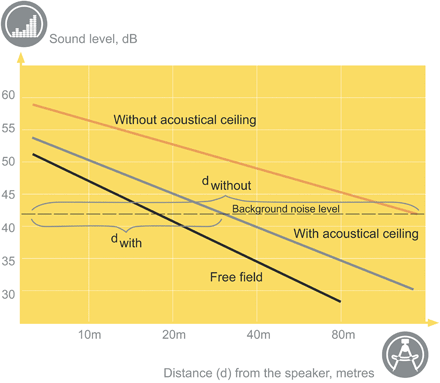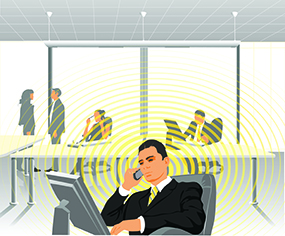Open-plan rooms
What to consider when planning open-plan spaces
To create a good sound environment in an open-plan room it's necessary to consider both:
- the reverberation time
- the size and shape of the room
It's also important to consider how the acoustic planning will affect the propagation of sound.
Speech the most disturbing factor in open-plan rooms
The main acoustic source of disturbance in an open-plan area is usually speech. It is therefore important that people who need to communicate sit near each other while, at the same time, different work groups must be separated acoustically to not disturb each other.
 Benefits of acoustic ceilings in open-plan areas
Benefits of acoustic ceilings in open-plan areas
To achieve acceptable acoustic conditions in an open-plan area, a sound-absorbing ceiling is a must.
To achieve the best possible acoustic effect the ceiling must have a high absorbation factor and be installed at as low level as possible.
The figure shows that an acoustical ceiling:
- reduces the sound level
- increases the reduction in sound level over distance
This also means a shorter required distance between work stations in order to achieve an acceptable sound level (i.e. a speech level that does not disturb or distract).

Sound absorbing ceilings improve the function of screens
An absorbent ceiling in an open plan area will also improve the function of screens and other screening furnishings.
The degree to which a ceiling improves the effect of screens can be classified in an AC value (Articulation Class). The AC value is determined in accordance with ASTM E 1110 (2001).
For an office ceiling, the AC value should be at least 180.
Characterisation of sound propagation

To characterise the sound’s propagation, there are descriptors that describe how much sound that diminishes per doubling of distance.
The descriptor DL2 (measured in dB) states the gradient of the sound propagation curve.
Another descriptor DLf (also measured in dB) states how the sound level at a certain distance behaves in relation to the sound level at the same distance in a free sound field, i.e. without reflecting objects.
By increasing the DL2 value and simultaneously reducing the DLf value, the distance to the place where the sound level is no longer disturbing will have decreased.
